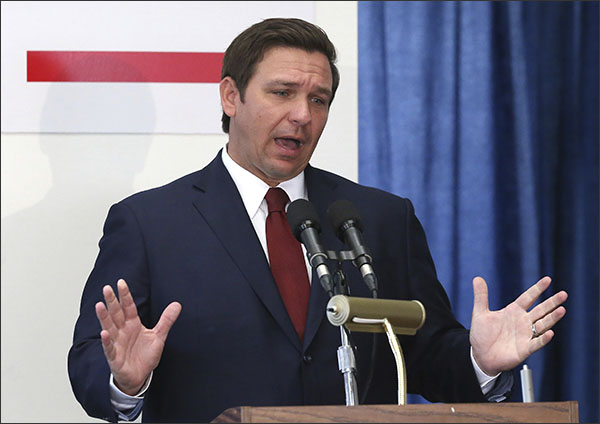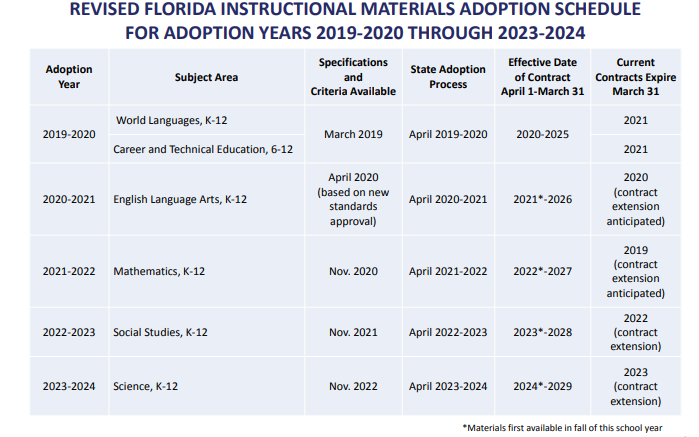Ed. Companies in Limbo as Florida Delays Curriculum Adoption Amid Standards Overhaul

Florida officials are delaying the adoption of a wave of new instructional materials in math and English/language arts in the wake of Gov. Ron DeSantis’ recently announced push to scrub the state’s standards of any influence of the common core.
A document posted on the state department of education’s website on Wednesday puts forward a revised adoption schedule that is supposed to mesh with the governor’s proposed standards overhaul.
The revised schedule—which the state’s department of education confirmed to EdWeek Market Brief—covers a variety of subjects up for adoption, from world languages to social studies to science.
But the subjects that are of the most immediate interest to publishers around the country are in math, because that adoption cycle had already been underway, and in English/language arts, which had been scheduled to play out in 2019 and 2020.
Florida is one of the biggest K-12 markets in the country, and getting on the list of approved materials can give curriculum companies potential entry to vast amounts of business in the state’s school districts. The importance of getting on the Florida adoption list was evident in the swarm of companies that sought to have their math materials approved: 140 bids from vendors around the country were submitted, according to the state.
The math and ELA adoptions will now be delayed, according to the state. Math adoption will take place in 2021 and 2022; ELA will play out in 2020 and 2021.
The state’s document also indicates that current contracts for instructional materials in math, ELA and other subjects that were set to expire will be extended, though it offers no details on that process.
See the full, revised schedule, below:

The decision comes in the wake of Gov. DeSantis signing an executive order two weeks ago that the state review its current standards and eliminate all traces of the Common Core State Standards from them.
The order from the Republican governor, who was elected last fall and criticized the common core during his campaign, orders the state’s commissioner of education to review the current standards and craft a plan to “eliminate” the common core. (See my colleague Stephen Sawchuk’s post on the subject.)
But how DeSantis’ plan will actually play out in districts–and in the marketplace–remains unclear.
The Common Core State Standards are academic benchmarks established by a group of states that spell out what students should know in English/language arts and math. In the years after they were finalized in 2009, 45 states and the District of Columbia adopted them, with governors and legislators from both parties arguing that they would set a high bar for students to reach.
But a backlash soon followed, led mostly by political conservatives suspicious of the Obama administration’s support for the standards.
Florida answered those critics in 2014 by revising its standards. But while the standards stripped the common-core branding from the documents, they remained substantially linked to the common core.
DeSantis’ executive order did not offer specific critiques of the standards’ content, but it calls for a “return to the basics of reading, writing, and arithmetic.”
A Flood of Applicants
In Florida, when vendors have their print and digital materials approved by the state, it means districts can use state funds to buy them. But getting on the adopted list is also important, more broadly, because K-12 districts tend to see the state-approved list as an important reference document for determining which commercial materials marketed to them are high-quality.
Two other important K-12 markets, Texas and California, have given districts more flexibility in recent years to stray from the state-adopted list. Florida has also granted districts more leeway. State law says that districts can spend up to 50 percent of the money they get from the state for other materials that assist with instruction. And the law also gives districts freedom to use different materials if the district can prove they meet various benchmarks.
A long list of publishers had already submitted materials to the state in math this cycle, hoping to get on the list of adopted materials. They include some of the biggest names in the industry, as well as mid-sized and smaller companies. Pearson, McGraw-Hill Education, Houghton Mifflin Harcourt, Curriculum Associates, Great Minds, and others were among the applicants.
In English/language arts, companies were originally expected to give the state notice of their intent to bid by April.
It’s unclear what the adoption of new standards—and the revised schedule—will mean for publishers who have already submitted math materials. Presumably, they would have to re-submit new materials later, to meet the state’s new adoption deadlines.
The standards overhaul also carries big implications for assessment, too, because state tests—and by extension, classroom-level assessments—are supposed to reflect standards content.
Diana Snider, the president of the Florida Council of Teachers of Mathematics, said she needs to see what ideas emerge about changing the math standards, before passing judgment on the governor’s plan.
DeSantis’ comments about a need to return to the “basics” of math, she said, probably reflects the complaints of some Florida parents that the approach to teaching math in the common core differs from what they’re used to.
Snider does think the current standards need improvement in some areas, such as at the high school level, where she sees too much repetition in how they cover algebra 1 and algebra 2.
To sort through that duplication and hone in on what’s essential in the standards, many Florida teachers turn to test-item specifications the state has put forward, which are more focused, Snider said.
But there are also many strengths to the standards, such as their focus on teaching both math procedures and broader math concepts, argued Snider, who is the manager of math, science, STEM, and arts education in the Palm Beach County school system.
As a result, Snider says the current generation of Florida students—including her middle-school-age sons—“have the ability to problem-solve in a variety of ways,” that were not encouraged before.
“They’re not just writing an answer that comes out of a calculator,” she said.
Ultimately, Snider says her organization wants to be “active participants” and have a “seat at the table” during the standards overhaul.
Whatever the outcome for educators and publishers, the governor’s proposal seems to have struck the right note with the general public. Fifty-two percent of residents approve of eliminating the common core from state exams, and just 21 percent disagree, according to a poll released by Florida Atlantic University.
Photo: Florida Gov. Ron DeSantis speaks at a pre-legislative news conference, Wednesday, Jan. 30, 2019 in Tallahassee, Fla. —Steve Cannon/AP
Follow EdWeek Market Brief on Twitter @EdMarketBrief or connect with us on LinkedIn.
See also:

“But a backlash soon followed, led MOSTLY (emphasis mine) by political conservatives suspicious of the Obama administration’s support for the standards.” This statement provides the perfect illustration of what is lacking in journalism today- facts. The word MOSTLY means “as regards the greater part or number.” Mr Cavanaugh, can you substantiate your use of that word with data? No, you cannot. Why, because it is not al all true. The two people who objected to the CCSS most vociferously were none other than Drs. Sandra Stotsky and James Milgrim- both former members of the CCSSO Validation Committees, the former on the English and Language Arts and the latter on the Science and Math. They quickly saw the problem- standards which were not written by experts in the field, were not based on scientifically verifiable evidence and were unacceptable. They both resigned and became outspoken and tireless critics of the CCSS which have now morphed into this behemoth nightmare of testing, data collection, experimental pedagogy and a new untapped resource of profits for unscrupulous profiteers. Who else is vociferous in their objections? Teachers, parents, grandparents- folks who can see this scheme for what it is and are desperately trying to protect their children from these bureaucratic laboratories. To try to lump them all in this ubiquitous basket of “CONSERVATIVES” is a disgraceful insult to the true stakeholders. These are OUR children, not yours, Mr Editor, Mr Politician, Mr Businessman. You will NOT have them for your guinea pigs. We aren’t so easily categorized, be warned. That’s what the election 0f 2016 was all about- the so-called Flight 93 Election. We’re fighting for ourselves, for our kids, for our country. Big brother is going too far and we are not going to stand for it any longer.
“But a backlash soon followed, led MOSTLY (emphasis mine) by political conservatives suspicious of the Obama administration’s support for the standards.” This statement provides the perfect illustration of what is lacking in journalism today- facts. The word MOSTLY means “as regards the greater part or number.” Mr Cavanaugh, can you substantiate your use of that word with data? No, you cannot. Why, because it is not al all true. The two people who objected to the CCSS most vociferously were none other than Drs. Sandra Stotsky and James Milgrim- both former members of the CCSSO Validation Committees, the former on the English and Language Arts and the latter on the Science and Math. They quickly saw the problem- standards which were not written by experts in the field, were not based on scientifically verifiable evidence and were unacceptable. They both resigned and became outspoken and tireless critics of the CCSS which have now morphed into this behemoth nightmare of testing, data collection, experimental pedagogy and a new untapped resource of profits for unscrupulous profiteers. Who else is vociferous in their objections? Teachers, parents, grandparents- folks who can see this scheme for what it is and are desperately trying to protect their children from these bureaucratic laboratories. To try to lump them all in this ubiquitous basket of “CONSERVATIVES” is a disgraceful insult to the true stakeholders.
Hello Tough Granny (or MJ Kurdys): Happy to respond. You asked if I can substantiate the statement. The answer is yes, because Education Week closely tracked the backlash to the Common Core where it was most influential — in state governments, which approve or reject state standards. In the years after states took up the Common Core (roughly 2010-2015) many bills and executive orders were put forward to either repeal, reject, or reduce the influence of those standards. Ed Week’s tracking of these measures showed that: 1 — Seven executive orders opposing the Common Core were introduced by governors, six of them by Republicans. 2 — Twenty bills to pause or review the standards were introduced, 14 by Republicans. 3 — Thirty measures were were introduced to repeal the standard, at least 21 by Republicans. These are my rough counts, based on our data. You can see them yourself in this Education Week tracker: https://www.edweek.org/ew/section/multimedia/2014-anti-cc-tracker.html There were of course many opponents of the common core on both the left and right of the political spectrum. But my reporting is backed up by the data. Thanks for reading the piece. Sean Cavanagh
This exchange is why I appreciate Education Week’s journalistic and fact-based approach over left or right wing rhetoric for and against controversial education policy. Too much heat out there, not enough light. Thanks EdWeek.
cloroquina 250 mg https://chloroquineorigin.com/# hydroxychloroquinr